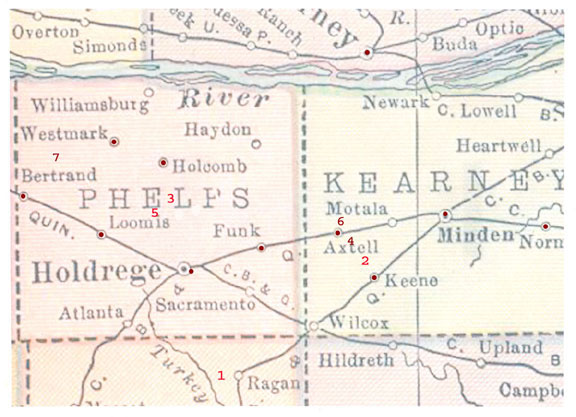
To review: 1. Scandinavia Post Office, (Immanuel church); 2. Bethany "mother church";
3. Phelps Center; 4. Salem Methodist; 5. Moses Hill; 6. Bethphage Mission; 7. Adullam Lutheran
Red dots mark other locations
with Swedish churches
We have seen the Phelps Center and Moses Hill stories in the central part of the county, and the northward movement from Scandinavia to Bethany in the south. The railroad's influence was of prime significance. As Holdrege and the other towns along the lines grew, they took their place in the immigrant church story. These were the last of the "seismic" events shaking the ground at Svea, and from this time the changes were more gradual and predictable. They left "sedimentary" layers, but few upheavals.
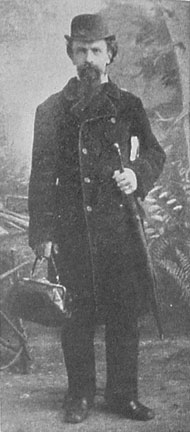
Fredrik Franson left his mark on Svea settlement
The success of Franson's church formula for the majority of people in and around Phelps Center is evident to this day. But we should remember the "upheaval" it caused for those who had other ideas. We have some direct evidence of this from our sources. First consider the comments by the Augustana Lutheran historian C.F. Sandahl concerning the prospects Bethany church had in the Keene community to its south:
Pastor Thoreen "advocated the building of a chapel in the village of Keene, four miles southeast of Bethany, and got permission to solicit subscriptions for it. This was, however, never realized and this place became the playground for sectarians, who looked on Bethany as a special field for their operations"
In the Keene "playground", the Methodists were followed by another of the Franson churches. We learn from Danish Lutheran sources that Pastor Simon Larson was the first resident pastor at Keene while he was also serving their West Mission congregation over toward Minden. We cannot document that Franson advocated pan-Scandinavian congregations, but his home conference was Swedish-Danish, he visited both Denmark and Norway in his missionary travels, and his adventism suggests a breaking down of national barriers. (A Franson congregation at Industry, between Holdrege and Atlanta, did not survive but an American Methodist church was there).
 _
_
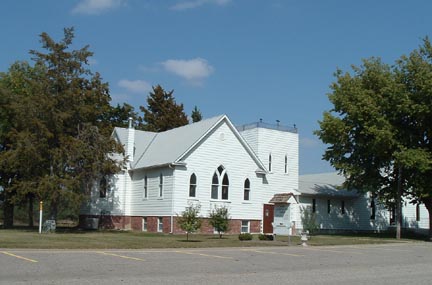
Old and new views of Keene; another Franson "church of God"
The decline of Phelps Center and movement toward Holdrege left something of a vacuum in the central and north parts of the county. That vacuum was filled by the Holcomb and Westmark churches which had an uncontested field there.
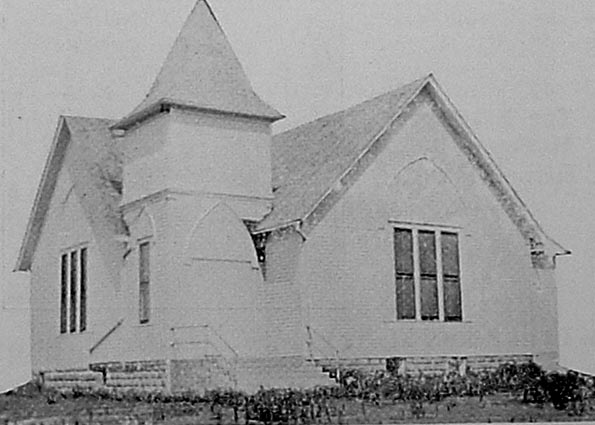 _
_
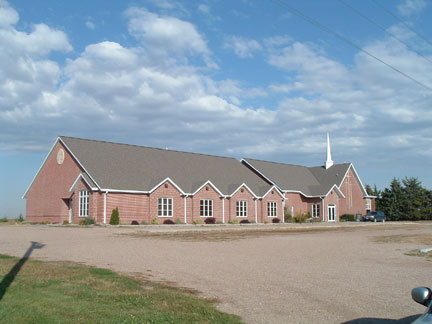
Old and new views of Holcomb
Last but not least, the Westmark Church of God in the northwest part of the settlement. Home to my wife's family and the place of our marriage. Westmark was one of the Franson churches which alternately called Covenant and Free ministers. It is not clear that the ultimate direction of the Swedish Evangelical Free denomination was exactly what Franson had in mind.
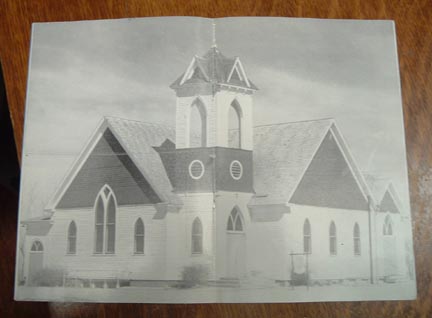 .
. 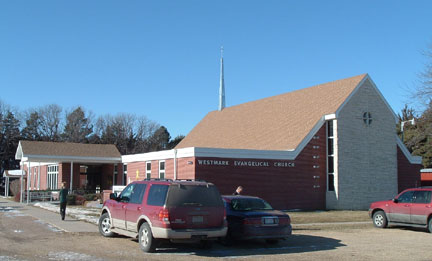
Westmark Church, old and new
* * *
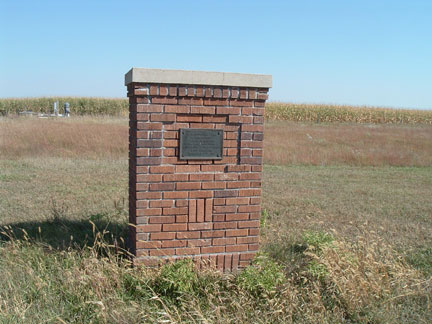
The first Holdrege church site
The rural Bethany Lutheran where our story began is described as a "mother church" with a number of offspring. Immanuel (Scandinavia) we have already seen, was a daughter "left behind". Bethel of Holdrege, along the railroad, is another offspring. Bethel, too, began as a sod church just east of the town. Initially it was served by the same pastor as Bethany, but eventually grew into independence. As Holdrege grew to prominence as the leading center of the area, a new Augustana Bethel church was built in the town.
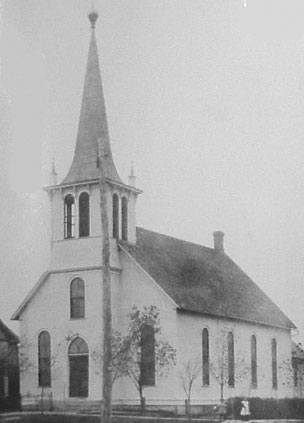
The 1885 Bethel church, burned and rebuilt
Again, Sandahl says of Bethel in Holdrege: "It was not to be expected that Bethel should be exempt from attacks by unreasonable and fanatic sectarians. Bethel was to go through a fiery test as well as all the rest of our early congregations. A spiritual prairie fire, started and kept up by proselyters, swept over Holdrege, with the particular object of devastating the Lutheran church. Unfortunately for themselves their condemnatory expressions harmed their own cause, so that they gained only a few adherents from our church. And though it was hot while it lasted, the fire left nothing to the incendiaries but empty blackness when it was over."
We cannot be quite sure whether these "sectarians" are the Swedish Baptists, Methodists or Mission friends since Sandahl does not dignify them by specific identification. There were both Mission and Methodist groups in Keene and all three in Holdrege.
Sandahl in 1931 marvels at how the Holdrege Lutherans have progressed in just fifty years, and how their roots in dugouts and sod houses are so quickly forgotten. Three-quarters of a century later we might have the same impression, as we stand on the site of their first sod church and cemetary, frankly looking neglected and obscure near the busy highways and railroad lines just east of the town.
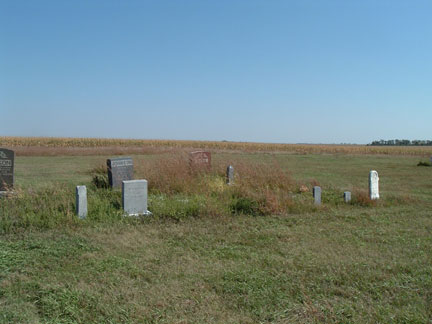
Have Bethel's roots been forgotten?
In those days, they either shared a pastor with rural Bethany, or relied on the services of their own laypastor O.G. Hedlund. Prosperity came quickly, and not even the defection of considerable numbers to the Mission and other competing congregations could prevent the building of the impressive edifice near the city center which stands to this day.

Bethel Holdrege: Augustana citadel
The center of gravity for the Swedish Free Mission people had shifted from Phelps Center to Holdrege. Here their congregation was organized and a church built in 1889. Their name, the Trinity Evangelical Church of Holdrege, was a more "churchly" sounding one than most of their Phelps County Mission church neighbors. (the Holcomb church took the name, Immanuel, but is rarely referred to this way) Our family has a connection with this congregation, as it was home to Eleanor's mother's family and was served by our great-uncle, Rev. Hugo Rodine in the thirties.
 -
-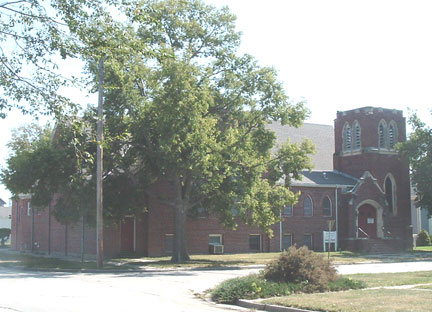
Trinity Evangelical Church of Holdrege in the 30's, and today as a Nazarene church
A source found at the Holdrege museum states that this church was chartered as "The Swedish Church of Holdrege, Nebraska", and that it took as its creed: "The Bible, free from all sectarian error, Old Testament and New Testament, the whole Bible (the Books of the Apocalypses not being included)..." This parenthetical phrase, if it is accurate, is remarkable. It would indicate a more nuanced Biblicism than that of any Mission congregation we have seen, including Mission Covenant churches, since the days in which the Augsburg Confession and the symbolic books were appended as part of the creedal statements. It would be even more remarkable if this phrase survived the pastorate of Gust F. Johnson at Holdrege, since he was an avowed fundamentalist.
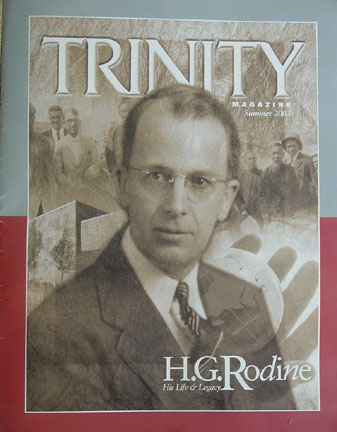 -
-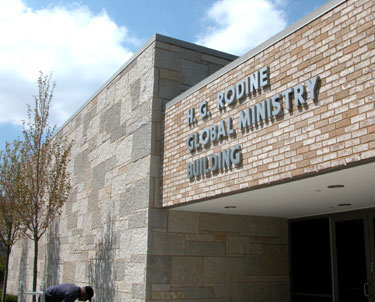
Hugo Rodine and the building honoring him at Trinity University
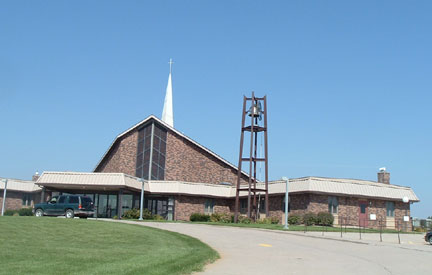
Trinity Evangelical Free Church, Holdrege
Legacy of Vännersburg
Phelps County Swedish Baptists
Thanks to Nebraska Swedish Baptist historian C.R. Osbeck we have details about their Holdrege church. In J.G. Blomquist's home down in Harlan County, the first meeting envisioning a congregation for that county and Phelps County was discussed. A year later, 1884, the formal organization was effected in Holdrege with student pastor Henry Nelson as "ordföreståndare" (chairman/elder) and ten members. By 1892 another student, Detlof Löfström had received ordination there and led the congregation in the building of a $1,495 church. Osbeck observes that this was not a small amount at the time.

This may be the Swedish Baptist church in Holdrege
(But might be the American Baptist church)
Though they had a building and little debt, after Löfström left there came a pastor unlisted among Baptist clergy and another who left the ministry after two years there. The congregation lay "fallow" till B. Fritzell conducts revival meetings in 1903 and the group finds synergy with another Baptist congregation newly formed at Emmaus, north of Funk. They are then able to call ministers jointly, including the colorful Olaf Lindh for 1915-16 and Hordville's O. Tornquist from 1918-20. Tornquist is also charged with shepherding the errant Verona congregation, just readmitted to Baptist standing after a season of "holiness" miscues. In 1922 the remaining 11 members under Rev. Forsander joined with the American Baptist congregation.
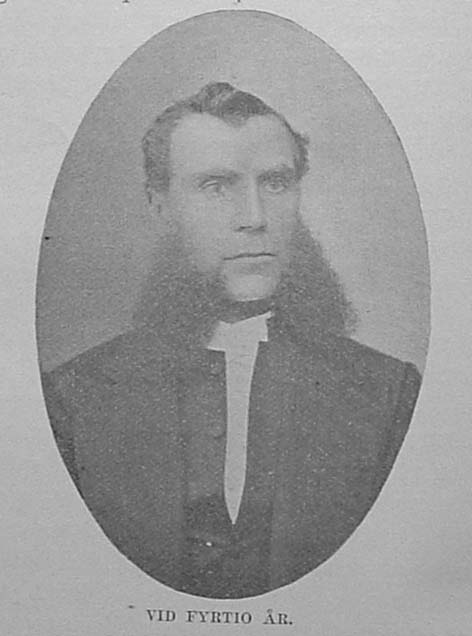 _
_
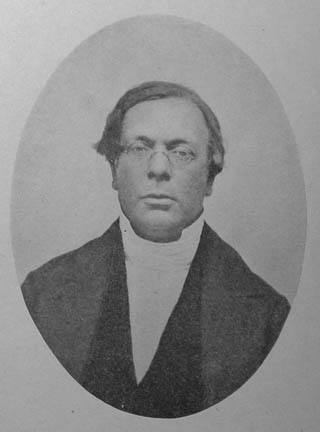
O.Lindh and T.N. Hasselquist: Baptist and Lutheran Rivals
In connection with O. Lindh, we have some choice words from his own memoirs. He was an influential leader among the Swedish Baptists throughout the immigrant settlements in America, as was his Lutheran counterpart, T.N. Hasselquist. Their rivalry was sometimes intense. The Baptist paper "Evangelisten" satirized Hasselquist by calling him "Hasselkäpper"; hazelwood "cane" instead of hazelwood bough, in translation. The implication was that Hasselquist stood ready to deliver a "caning" to his opponents; an appraisal that might have been shared by some Lutherans as well! In turn, Hasselquist was reported to have said of the Baptists: "kosta krut på nyggan", which might be translated "it is not worth wasting gunpowder on a gnat." These colorful exchanges have unfortunately been deleted by decorous historians of later days.
Between the two Lutheran churches of Bethany and Bethel existed a considerable number of Swedish settlers who envisioned a church of their own. Here church politics and personalities appear to have caused delay in the formation of an independent congregation. This was near the railroad town of Funk.

A sod church which "split"
The "in between" group wished to become a Lutheran congregation independent of the Bethany "mother church", but mother thought otherwise. The members then looked to another option, the Swedish Methodist Conference. There are two slightly different perspectives on this: Sandahl suggests that a more tolerant policy on the part of Lutheran leaders at the time might have prevented a division of this congregation. But it is known from Methodist sources and would be admitted by Sandahl that there were those members at Fridhem who had strong Methodist leanings from the beginning. This would have contributed to the Lutherans' reluctance to give Fridhem independent status early on. This appraisal from Methodist historian O. Chindberg in his "Gleanings from 50 Years" is conciliatory. He describes Fridhem in this way: "...a sort of community affair...though most were Lutherans...Who it was that stopped the use of that church by the Salem group, or how it came that its doors were closed for them is not definitely known."
One historian mused that they were Lutherans who wanted to form a Lutheran congregation, but the Lutheran leadership forbade it. When they began to align themselves with the Methodists, the sod church was closed to their meetings. This was too reminiscent of the arbitrariness of the Swedish state church they had left behind!
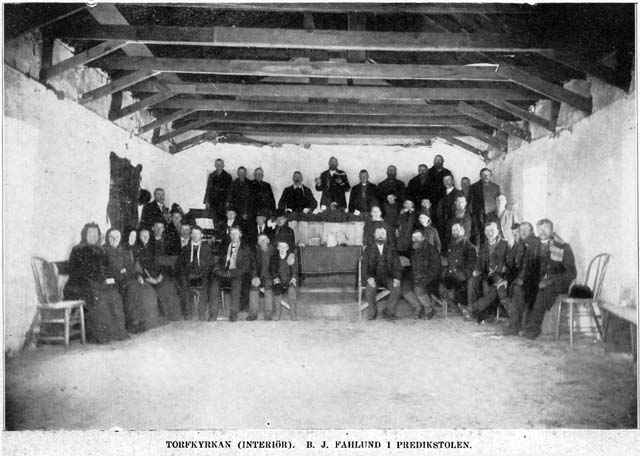
Fridhem Church interior
A rare look inside a sod sanctuary!
Amusingly, among Lutheran clergymen this Salem Methodist congregation was informally named after the Bethany pastor whose foot-dragging created the situation. Again, Sandahl does not name names. Here we have some irony: imagine splitting a sod church! The Fridhem Lutheran Church was eventually accepted by the Synod and its neighbors, and the sod structure was later replaced by a frame building. That church was moved into the town of Funk when the railroad came through.
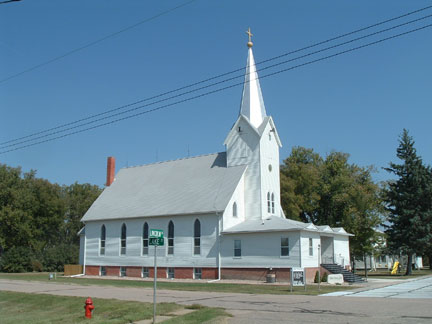
Fridhem Church appears about the same as 100 years ago!
This is the Lutheran side of the split
On the subject of Methodists, back at Keene, a family by the name of Burns had sought visits by Swedish Methodist ministers. They had earlier contact with this group and favored it. At the request of A.M. Burns, both Rev. O.J. Swan and Rev. J.A. Gabrielson visited the group. They reportedly had a church there in 1895 but only the cemetary remains, where the Burns family is buried. It was the group from Funk and their Salem Methodist congregation which built the strongest and longest enduring Swedish Methodist church in the region.
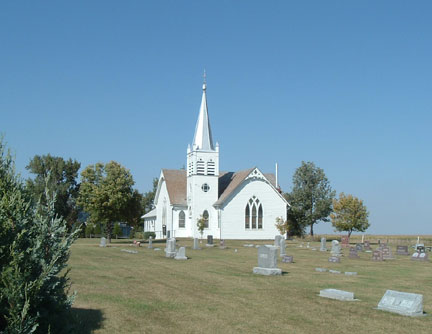
Swedish Salem Methodist church south of Axtell
It also appears about the same as 100 years ago!
Rev. John Simpson, pastor at Stromsburg, came down periodically to minister to the Salem congregation. The membership included A.P. Falk, Peter Ekwell and John Abrahamson, family names we remember from the adjacent cemetary. Their first permanent pastor was Carl Charnquist, who lived in Kearney and later wrote "En Torv Katedral", (A Sod Cathedral) about the contested Fridhem, Funk, church. The first Salem Church was built in 1884 and the present building shown replaced it in 1898. In 1972 the congregation formally merged with the Holdrege congregation.
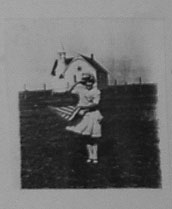 -
-
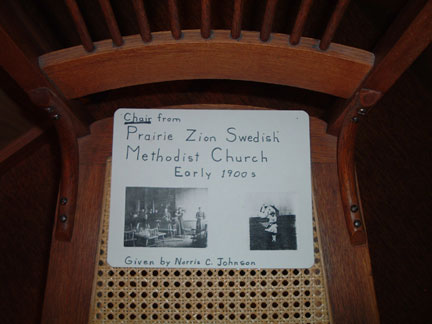
Prairie Zion Swedish Methodist church and a surviving chair
Another church, the Prairie Zion Swedish Methodist church, was located south of Holdrege and survived until about the time of the language change. This event also marked the end of a Swedish Methodist church in Holdrege and its merger with the American congregation there. When that church was torn down in the 1920's, only their cemetary remained to mark the location ("across from Conrad Johnsons").
Our second year's trip unearthed some specifics from the Holdrege Swedish Methodist history that we offer as counterpoint to Sandahl's observations above. It is always illuminating to see events from more than one perspective:
"Our Swedish work in Holdrege was started by the Rev. A.G. Milton in 1895, during the time he served the Axtell-Prairie charge. After a week of evangelistic meetings, which he conducted in the First Methodist Church, assisted by the Rev. A.J. Leafgren, the Swedish branch of the Methodist Episcopal Church was organized by the Rev. A.J. Leafgren, District Superintendent, at the residence of Mr. and Mrs. C.O. Olson...
The south room in the First Methodist Church was then secured for a few months and services were held there on Sunday afternoons. Rev. Milton filled the pulpit for some time and then a student, Theodore Peterson, was engaged from June until conference time in September. During his time a hall was secured, widely known as the "Winquist Hall," which became so crowded that it had to be enlarged...
During the winter of 1896 seven weeks of protracted meetings were held and a revival broke out, which made Swedish Methodism better known in the community. In 1897 the Swedish Baptist church was obtained and meetings were conducted there for a whole year. The parsonage and church edifice were built on two lots, 50x140 feet, on the corner of West and Ninth Avenues, during the ministry of Rev. A.R. Mellin. The parsonage was built in 1897. The church was built in 1899 at a cost of about $2,500 and dedicated in September the same year. According to conference report by Rev. Leafgren, it was the most beautiful church building in town."
 -
-
Once the Holdrege Swedish Methodist church: now apartments
The Swedish Conference of the Methodist Episcopal Church extended its mission from the Salem congregation south of Axtell to a church south of Holdrege called Prairie Zion and finally to Holdrege itself. These ultimately merged with the American Methodists in the mid-thirties at about the time the English language replaced the Swedish in the population.
Just outside of Funk to the northwest, a group of Swedish Baptists rallied under visiting preacher B. Fritzell to form a congregation called Emmaus in 1903. By 1907 they had 17 members and managed to encourage their neighbors in Holdrege to new strength with shared pastors. Here Osbeck's story runs up against an "inconvenient truth" in the form of the picture below. It is dated 1889, entitled the Emmaus congregation, and includes rather more than 17 people including a musical ensemble with a large drum! Returning to Osbeck's narrative, we find that he says "a door opened" at Emmaus in 1903. What this means, we can only surmize. By 1903 a congregation had existed in its own building for at least fourteen years! Either a segment of this congregation organized as Baptist in 1903, or perhaps the entire group sailed under that flag for a time. It is elsewhere described as a "union" church. That would suggest a mixed congregation of, probably, Baptists and Mission Friends. What is most remarkable is that, for all this obscurity, the church still exists!
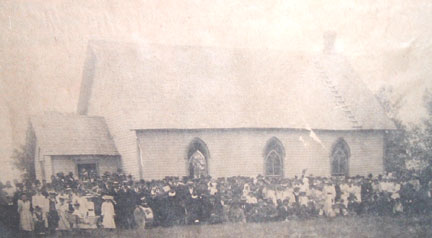
A picture to challenge history: old Emmaus "union" Church, rural Funk
The crowd above may have been attending one of the "mission meetings" typical of the time. We have seen a program from a union Sunday School training session held at Emmaus at which our forbear, Rev. Hugo Rodine, addressed the topic: "The importance of reverence during the Sunday School hour."
Of Fritzell we have no further information from Osbeck, and his name is not on the roster of Baptist seminarians. Circumstantially, a later Fritzell with a common initial emerges from the Arthur, Iowa congregation and is baptised in Minneapolis as a "Free Baptist." Though the Free church history of the thirties does not mention Emmaus, we know that it is now part of their organization. We might surmize that this is one of the groups that moved from Baptist leanings to Free Mission affiliation. A group of Waldenströmian Baptists had seceded from the Kiron Baptists near Arthur in those days.
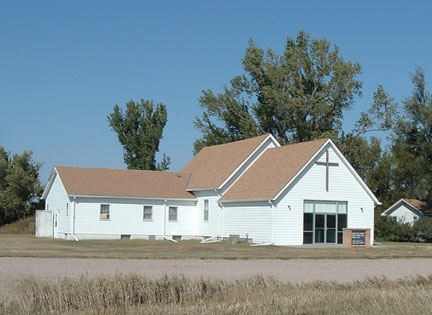
One of those wonderful survivals, now Emmaus Evangelical Free
* * *
We find ourselves moving along the timeline now, and filling in additional congregations mainly along the railroad. Mother church Bethany has yet more offspring to consider. To the east, Minden saw the birth of the Nazareth congregation. Minden was home to more Danes than Swedes. The Danish Lutherans were hospitable to Bethany's child there, but it was not a strong group and by 1931 Sandahl was ready to recommend their simply joining with the Danes.
Axtell, just to the north of Bethany, had been considered as a good location for Bethany itself at the time the sod church was replaced by a new frame building. This did not occur at that time. As more Bethany members retired to Axtell, an annex chapel was developed on lots purchased there. Inevitably, this group sought to have their own independent congregation and this came about in 1911 with 73 charter members. Though these had been Bethany members before, the mother church was still left with over 400.
Initially served by Bethany's pastor, the new Bethphage church called K.G. William Dahl as pastor in 1912. Dahl had been involved in the Omaha Immanuel hospital work and soon was at work building a home of mercy at Axtell. The wonderful success of this ministry, the Bethphage Mission (now Mosaic ministries) deserves its own section, which can be accessed on the link below.

The campus of Bethphage is a fitting monument to its founders

K.G. William and Lillian Dahl among a hundred or more graves of those they served
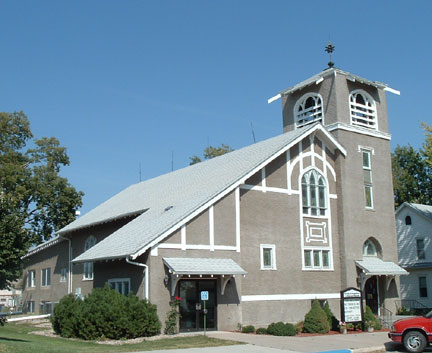
Originally called Bethphage, now Trinity, Axtell
this church, too, is little changed
The Swedish Salvation Army goes unchronicled insofar as a written history goes to the best of our knowledge. But their work is remembered in many communities as are their buildings. In Holdrege they began in September, 1919, and for thirteen years met in an upstairs rented hall on East Ave. Another source traces their beginnings to 1916 when their leaders were Capt. Anna Hjelm and Lieut. Olga Olson and they met in the Congregational Church (where the "Dr. Wilcox home now stands"). They progressed to their own building, pictured, in spring of 1934, and continued in some form till the 1950s. This building on East Ave. no longer stands and it appears that the lot is vacant. Staff at the Holdrege museum recalled that their genealogical society met in this building at one time.

The Swedish Salvation Army building in Holdrege
* * *
Along the Burlington Line
As the railroad station towns developed with growing populations, more churches were formed. Axtell and Holdrege are joined by Minden, Funk, Loomis and Bertrand, all along the Burlington line. Today coal trains continue to run over both the Burlington Northern Santa Fe and the Union Pacific just north of the Platte. The Amtrack passenger Zephyr still makes its nightime passage through Svea, but how many of the riders know of its story?
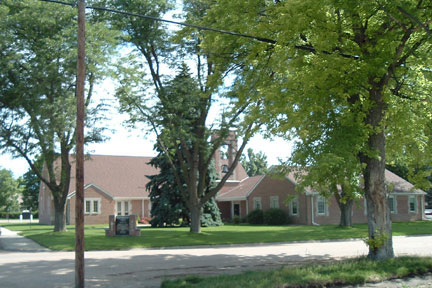
Today's Immanuel Lutheran Church of Bertrand
Though we did not make it to the western part of the Svea settlement in our first visit, we returned the next year to focus on that part of the area, including the story of the Westlandia church. There was a nucleus of Swedish immigrants in the Bertrand area which was appraised adequate for the formation of a Lutheran congregation there. Rev. Swanbom of the rural Bethany "mother church" had visited the Axelson settlement north of Bertrand as a mission outpost and it came to the attention of the Nebraska official of the Kansas-Nebraska Conference that a church should be chartered. The official who presented this proposal at the 1883 annual meeting in Oakland was none other than the Rev. J.P. Nyquist, of whom Sandahl has some curious thing to say. He had been president of Minnesota's Gustavus Adolphus college and was there criticized as a "misfit because of his ultra-Swedish ways." Having come to serve the Malmo congregation, he was a candidate for the presidency of the new Luther College at Wahoo. This initiative was thwarted through political maneuvers hinted at by Sandahl.
His designs at Axelson had a happier outcome, as this industrious new group proceeded to innovate the construction of a church building christened "Westlandia" with materials salvaged from a schoolhouse west of Kearney.
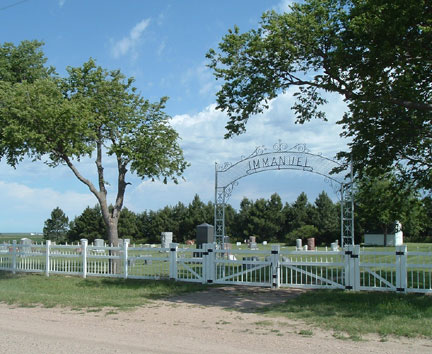
Axelson and Westlandia are gone, but the cemetary remains
Augustana stalwart Reuben Swanson a recent burial
But when the time had come to build a parsonage, the perennial problem of the railroad bypassing a budding community raised its head. Axelson was on the wane while Bertrand station waxed. The decision to build in "town" was followed by ambitions to have a congregation with two locations. A new "Westlandia" would be built in Bertrand, (now called Immanuel) while the old church would be moved to the northeast to serve that part of the settlement.
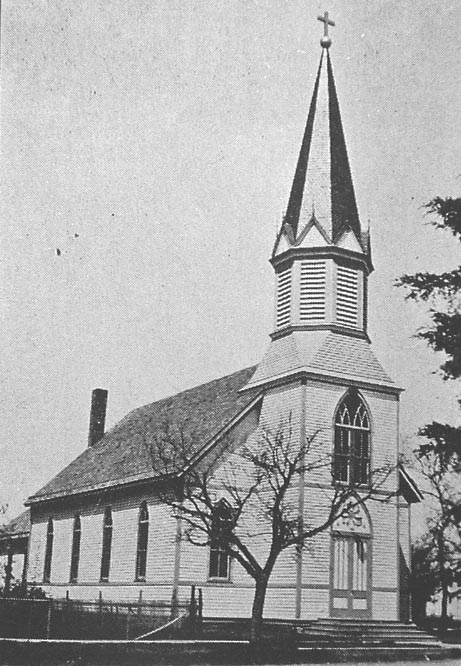
West of Holdrege along the rails: Bertrand's "Westlandia" church
The outcome was that two congregations resulted. The northern was called "Adullam" and was served by the same pastor as Westlandia's. Eventually Adullam would have a new building and a long history, though its beginnings bely an independant streak that are typified by the failure to keep records (or the decision not to do so, characteristic of "free" Lutheran impulses of the time) or to consult seriously with denominational leaders in their decision making.
Sandahl's Conference History preserves a favorite story about Adullam:
"The church building was moved by oxen, and these oxen had the decision about its location. It is said that when the oxen came to the location first picked out, they would not stop there but continued about sixty rods farther, to the northeast corner of the section, and so the church was placed just across the road from where the present church stands. N.P. Lundvall donated the first plot of ground for the church. Five acres were later bought from P.O. Hedlund for parsonage purposes."
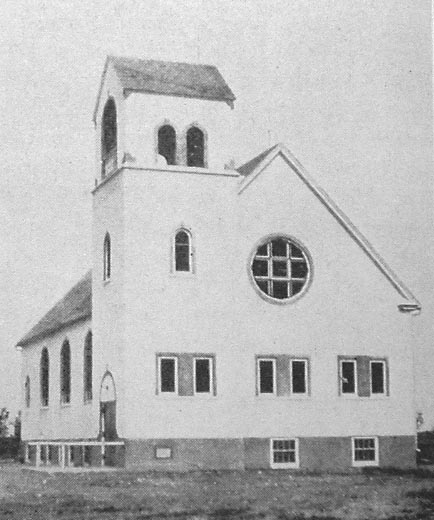
The northern heir of Axelson: Adullam Lutheran
We note that P.O. Hedlund was the son of pioneer Phelps area lay preacher Olaf Hedlund. Of him Sandahl reports: "Here he built himself a sod house and a blacksmith shop. A government official, who passed his shop on the Kearney and Orleans Mail Route, saw the advantage of making the place a station and called it Blacksmith Ranch, a name which it bore until the railroad came. It served as post office and stopping place for numerous wagon trains, freighters, and wayfarers. Phelps County was reorganized in 1877, with Phelps Center as county seat. Here Hedlund served as county treasurer, and his son P.O. Hedlund, as county clerk and surveyor."

Adullam Lutheran today
Adullam has been served as a joint parish with Immanuel Bertrand, in Sandahl's day it had one Sunday morning service a month with the remaining Sunday services being at 3:00 P.M. so that one minister could lead both congregations.